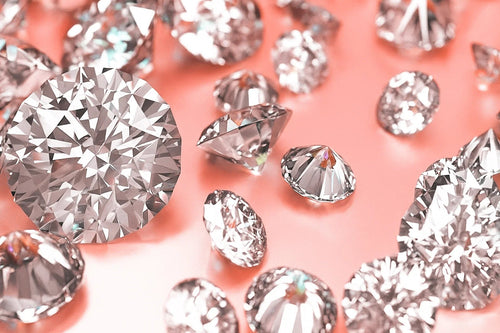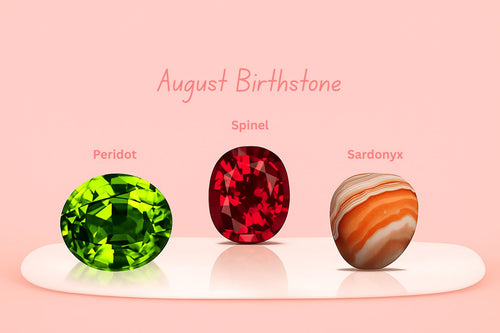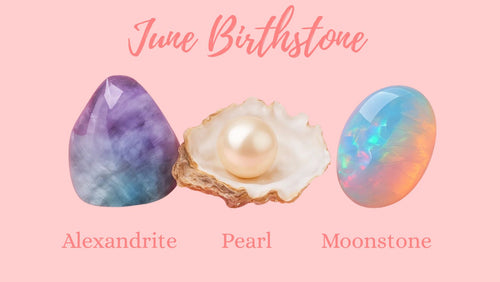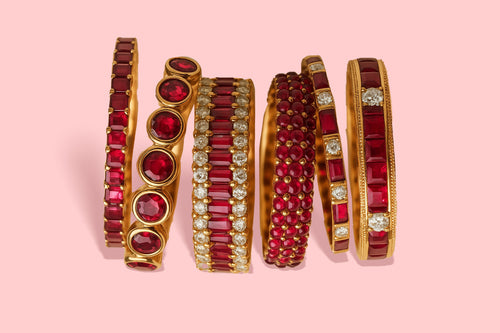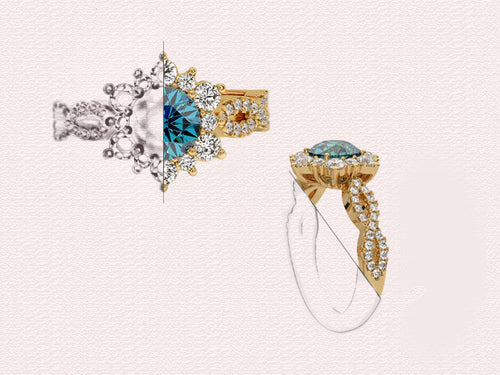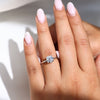Welcome to the Avideri Diamond Guide your trusted source for expert insights into the world of diamond. At Avideri, we believe every diamond tells a story. Whether you're selecting the perfect engagement ring, exploring the 4Cs, or deciding between lab grown and natural diamonds. Our guide is here to educate and inspire. With timeless elegance and modern transparency, we simplify the diamond-buying journey so you can make a confident, meaningful choice. Let’s uncover the brilliance together.
Our goal is simple: give you the confidence to choose a diamond that feels like it fits. Whether you’re selecting an engagement ring, shopping for a personal piece, or exploring options, this guide covers everything carat, cut, shape, metal choices, and style preferences all broken down in a way that makes sense.
1. Understanding Diamond Sizes
When people talk about diamonds, one of the first things that comes up is size, usually measured in carats. But what most buyers don’t realize is that carat weight doesn’t directly translate to visible size. In fact, focusing only on carat can be misleading if you don’t also consider cut and proportions. That’s why our Diamond Guide helps explain how size, cut, and shape work together to create the look you really want.
Carat vs Actual Size
Carat is a unit of weight not size. A one-carat diamond doesn’t always look the same across all shapes and cuts. For example, a one carat round brilliant diamond may appear smaller than a one carat marquise or oval because of how the weight is distributed. Deep cuts tend to concentrate the weight at the base, making the diamond appear smaller from the top view. On the other hand, shallow cuts can make a diamond look larger, but they might compromise brilliance. This is why visual size depends just as much on the craftsmanship as the number.
How Size Looks on the Hand
Another important factor is hand and finger proportion. A diamond that looks bold on someone with slender fingers might appear modest on someone with larger hands. If you want a diamond that feels balanced noticeable but not overwhelming the shape, finger length, and even skin tone can all influence the best size for you. For instance, elongated shapes like oval and pear can give the illusion of more size, especially when worn on slender fingers.
Size is Personal, Not a Status Symbol
There’s often pressure to go bigger, but it’s important to focus on how the diamond feels on you. A well-proportioned 0.75-carat diamond might suit your hand and lifestyle better than a bulkier 1.5-carat stone. At Avideri, we encourage customers to prioritize comfort and proportion over size alone because a diamond you enjoy wearing every day will always feel more valuable than one chosen only to impress.

2. The Role of Cut, Shape, and Proportions

Why Cut and Shape Matter
While size gets the attention, cut and shape are the real game-changers in how a diamond performs. These features control how the diamond interacts with light and how it looks on your hand. Our Diamond Guide breaks down the technical side of these aspects, helping you choose a diamond that not only looks good but also fits your lifestyle.
Cut vs Shape
Cut and shape are often confused. Shape is the outer form round, princess, pear, etc. Cut, on the other hand, refers to how well the diamond has been crafted. A well-cut diamond reflects light evenly, offering more brightness and a balanced appearance. Poorly cut diamonds, even if larger, may look dull or uneven. In other words, a 1-carat diamond with an excellent cut can appear more vibrant and attractive than a 1.25-carat diamond with a poor cut.
Understanding Shapes
Round: The most symmetrical shape, offering maximum brilliance. Ideal for traditional settings but works in modern ones too.
Oval: Gives a longer visual appearance and often looks larger per carat. Great for elongating shorter fingers.
Emerald: Known for its step cuts and long lines, it has less sparkle but offers a sleek, clean look.
Pear: A bold choice that combines round and marquise elements. It’s unique and adds a strong personality to the ring.
Cushion: Rounded corners and a soft square shape. This shape has a deep body, which may make it look smaller but adds a vintage touch.
Why Proportions Matter
Proportions affect how the diamond carries its weight and how it plays with light. A stone with ideal depth and table percentages will perform better visually than one with slightly off dimensions. Even two diamonds with identical shape and carat can look and feel entirely different on your hand if their proportions differ.
3. Style Choices That Work for You
Diamond style is about more than appearance it’s about personality. Choosing the right style involves understanding your habits, your vibe, and how you want the diamond to fit into your life. The Diamond Guide helps you explore styles that suit your routine, whether you wear it daily or just on special occasions. Whatever you choose, the style should always feel natural.
Minimal vs Bold
Minimalist designs like solitaires with thin bands are clean, practical, and easy to wear every day. They suit people who prefer subtle elegance and don’t want anything bulky on the finger. On the other hand, bold styles like halos, double bands, or dramatic shapes are great for making a visual statement. These designs tend to draw attention and work well for special occasions or people who enjoy expressive accessories.
Choosing the Right Metal
The metal you choose changes the entire feel of the ring. Here's how:
- Yellow gold brings warmth and adds contrast to colorless diamonds, making them pop.
- White gold offers a neutral tone that blends with the diamond’s color and gives a more streamlined look.
- Rose gold adds a soft pinkish hue that feels modern yet warm.
- Platinum is hypoallergenic, durable, and has a muted tone that pairs well with bold or geometric cuts.
The metal should complement both your diamond shape and your skin tone. At Avideri, we often recommend viewing your preferred shape in multiple metal types to see how the overall feel changes.


Lab Grown vs Natural Diamonds
Both lab grown and natural diamonds are real diamonds. The only difference is how they’re formed one in a lab using advanced technology, the other deep within the earth over millions of years.
Lab grown diamonds are more accessible in price, allowing for bigger sizes or higher grades without compromising look.
Natural diamonds carry geological rarity and long term resale value.
The Diamond Guide at Avideri helps you compare both options so you can choose based on your preferences and goals.
4. Caring for Size and Style
Once you've chosen the perfect diamond, maintenance becomes the next important step. How well you care for your diamond especially depending on size and setting will determine how it holds up over time. The Diamond Guide offers tips on keeping your diamond looking its best for years to come.
High vs Low Settings
A high setting elevates the diamond above the band, making it more noticeable. It can also make the stone easier to clean and catch more light. However, it increases the risk of snagging on clothes or knocking against surfaces. Low profile settings sit closer to the hand, offering more comfort and protection great for people who work with their hands. The Diamond Guide helps you weigh these pros and cons to find the right setting for your lifestyle.
Routine Maintenance
- Clean your diamond weekly with mild dish soap, warm water, and a soft brush.
- Rinse and dry thoroughly to prevent residue buildup.
- Every 6 12 months, visit a jeweler for a quick inspection to ensure the prongs are secure.
- If you notice looseness or dullness, don’t delay small problems can lead to larger damage.
Future Proofing Your Style
Tastes can evolve. Maybe you start with a simple solitaire and, over time, decide to add a halo or side stones. Or perhaps you want to reset the same stone into a new band for an anniversary. At Avideri, we design all rings with long term flexibility in mind making resizing, re setting, or upgrading part of your journey, not a problem. The Diamond Guide highlights how to plan for future changes without compromising your current style.
5. Final Thoughts: Choosing Based on What Matters to You
The perfect diamond doesn’t come from a magazine, an ad, or a trend. It comes from knowing what feels right on you. This Diamond Guide by Avideri was made to help you block out the noise and trust your own taste.
Don’t get distracted by charts or pressure. Use them as tools, not rules. Whether you choose a lab grown emerald cut in rose gold or a natural round in platinum, what matters most is that you enjoy it. You’re not just buying a diamond you’re choosing a piece that joins your daily life.
At Avideri, we’re here to guide, not push. We’re about giving you tools, not templates. Because real beauty isn’t about being perfect it’s about being personal.

